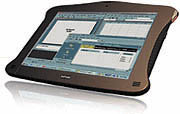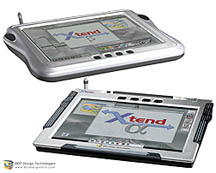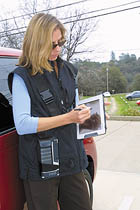|
|
|
MIRAAirSpeak FlairThe Flair is a wireless monitor aimed at the enterprise market rather than the home market. It was initially designed to wirelessly connect to a "corridor cruiser's" desktop PC and provide remote mobile access to the desktop. The Flair is similar to the Mira in that it's a Windows CE device with integrated WiFi (802.11b) wireless, except that the protocol used between the Flair and a desktop PC is proprietary. The Flair is a more open platform than the Mira, since it can also be configured as a wireless thin client or a CE tablet. When the Flair is configured as a thin client, the protocol used between the Flair and a server can be either Microsoft's RDP or Citrix's ICA. When it's configured as a CE tablet, the Flair can support wide-area wireless (CDPD or GSM) as well as WiFi. AirSpeak's primary target markets for the CE tablet version of the Flair are healthcare, manufacturing and retail. List price of the Flair is $1,895 for the wireless monitor or CE tablet version and $1,695 for the thin client version. The Flair is similar to the Mira in that it's a Windows CE device with integrated WiFi (802.11b) wireless, except that the protocol used between the Flair and a desktop PC is proprietary. The Flair is a more open platform than the Mira, since it can also be configured as a wireless thin client or a CE tablet. When the Flair is configured as a thin client, the protocol used between the Flair and a server can be either Microsoft's RDP or Citrix's ICA. When it's configured as a CE tablet, the Flair can support wide-area wireless (CDPD or GSM) as well as WiFi. AirSpeak's primary target markets for the CE tablet version of the Flair are healthcare, manufacturing and retail. List price of the Flair is $1,895 for the wireless monitor or CE tablet version and $1,695 for the thin client version.
DOT Design Technologies XtendThe Xtend is closest of the four products in concept to the Mira. Created by a tiny startup in San Mateo, CA, the Xtend is like an enhanced Mira running Linux instead of Windows CE. According to Todd Shafer, President and Founder of DOT Design Technologies, the product is presently in the "virtual prototype" phase of development. DOT's philosophy strongly emphasizes the long-term benefits of an open design based on Linux. DOT also clearly understands that a device such as the Xtend is "primarily for read-only activities." There are two main areas where the design of the Xtend differs from Microsoft's concept of Mira: RDP and standalone applications. First, instead of Microsoft's RDP, the Xtend uses a proprietary protocol between the wireless monitor and the PC. Second, the Xtend includes a full web browser, an email client and accessory applications such as a universal remote control for audio-visual equipment, a calculator and a notepad. DOT's street price target for the Xtend is $699. According to Todd Shafer, President and Founder of DOT Design Technologies, the product is presently in the "virtual prototype" phase of development. DOT's philosophy strongly emphasizes the long-term benefits of an open design based on Linux. DOT also clearly understands that a device such as the Xtend is "primarily for read-only activities." There are two main areas where the design of the Xtend differs from Microsoft's concept of Mira: RDP and standalone applications. First, instead of Microsoft's RDP, the Xtend uses a proprietary protocol between the wireless monitor and the PC. Second, the Xtend includes a full web browser, an email client and accessory applications such as a universal remote control for audio-visual equipment, a calculator and a notepad. DOT's street price target for the Xtend is $699.
Panasonic Toughbook 07The Toughbook 07 was reviewed in the April/May issue of Pen Computing (issue #44, page 40 - see review. Like the rest of the Toughbook family of products, it's aimed at enterprise and government markets, not the home. Typical applications for the Toughbook 07 include law enforcement (e.g., bicycle policemen), aircraft maintenance and "line busting" (using a mobile POS terminal to shorten service lines). The Toughbook 07 consists of a "brick-like" base module and a handheld wireless monitor incorporating an 8.4" SVGA transflective TFT. The use of a transflective LCD allows operation indoors or outdoors; the wireless monitor is rugged enough to survive repeated four-foot drops to concrete. The Toughbook 07 is a full PC and can run any version of Windows (98, NT-4, 2000 or XP). It uses a proprietary protocol over a standard WiFi (802.11b) link between the base module and the handheld wireless monitor. The Toughbook 07 is sold through VARs and in quantity to large end-users (there is no published price). Typical applications for the Toughbook 07 include law enforcement (e.g., bicycle policemen), aircraft maintenance and "line busting" (using a mobile POS terminal to shorten service lines). The Toughbook 07 consists of a "brick-like" base module and a handheld wireless monitor incorporating an 8.4" SVGA transflective TFT. The use of a transflective LCD allows operation indoors or outdoors; the wireless monitor is rugged enough to survive repeated four-foot drops to concrete. The Toughbook 07 is a full PC and can run any version of Windows (98, NT-4, 2000 or XP). It uses a proprietary protocol over a standard WiFi (802.11b) link between the base module and the handheld wireless monitor. The Toughbook 07 is sold through VARs and in quantity to large end-users (there is no published price).
Sony AirboardThe Airboard is a wireless monitor that embodies the convergence of entertainment (TV and other audio-visual sources) and information (Internet access). As such, Sony puts the Airboard in a new device category called the "IT TV" (information technology television). The Airboard consists of a 12.1" wireless monitor connected via WiFi (802.11b) to a base station (not a PC). The base station contains the following functionality:
The Airboard is currently sold only in Japan. Satoru Maeda, creator of the Airboard and head of Sony's Personal IT division, told the author that introduction in the US was being considered but that it required careful, detailed planning in light of the US economy and Sony's recent experience with the eVilla (Sony's Internet Appliance that was pulled from the US market after only two months of sales). The street price of the Airboard in Japan is 130,000 yen (around $1,000). |
|
|
Unauthorized reproduction in any form is strictly prohibited. Contact the Pen Computing Publishing Office for reprint information. |